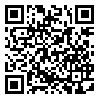Volume 10, Issue 4 (2021)
Naqshejahan 2021, 10(4): 255-263 |
Back to browse issues page
Download citation:
BibTeX | RIS | EndNote | Medlars | ProCite | Reference Manager | RefWorks
Send citation to:



BibTeX | RIS | EndNote | Medlars | ProCite | Reference Manager | RefWorks
Send citation to:
Ronagh E, Zandieh M. Exploring the Digital Approach to Redefining Decoration Design in Islamic Architecture Inspired by the Teachings of the Holy Quran. Naqshejahan 2021; 10 (4) :255-263
URL: http://bsnt.modares.ac.ir/article-2-41786-en.html
URL: http://bsnt.modares.ac.ir/article-2-41786-en.html
1- Architecture Department, Karaj Branch, Islamic Azad University, Karaj, Iran
2- Architecture Department, Architecture & Urbanism Faculty, Imam Khomeini International University, Qazvin, Iran , zandieh@arc.ikiu.ac.ir
2- Architecture Department, Architecture & Urbanism Faculty, Imam Khomeini International University, Qazvin, Iran , zandieh@arc.ikiu.ac.ir
Abstract: (3600 Views)
Aims: Contemporary architecture of Islamic countries as one of the common seasons of these countries, has always felt the lack of discourse between traditional and modern approaches to creating space in the design. So today's architecture has always been looking for creativity in the design process to make up for this shortage. Using the digital approach to redefining the process can help. In addition to beauty, decorations in Islamic architecture are the induction of concepts such as order and existential unity that are seen in the form of geometric and abstract motifs. Also, in Islamic teachings and the Holy Quran, a concept such as unity in multiplicity has been mentioned a lot. Redefining this concept with a digital approach to Islamic architecture decorations could be a new discourse between a traditional and a modern approach. In This study examine the role of digital approach in the manifestation of Islamic architectural decoration in the design process inspired by the teachings of the Holy Quran.
Methods: The research method that used in this study is "logical reasoning", using "analytical-descriptive" approaches with a qualitative approach.
Findings: The digital approach based on Bottom to Up method and focusing on the three areas of patterning and generative pattern, algorithm-coding, and digital fabrication redefine Islamic architectural decorations by changing the basic parameters and produces new patterns.
Conclusion: The fields of digital approach can design and produce Islamic teachings such as unity in multiplicity with geometric mathematical foundations in Islamic architectural decoration.
Methods: The research method that used in this study is "logical reasoning", using "analytical-descriptive" approaches with a qualitative approach.
Findings: The digital approach based on Bottom to Up method and focusing on the three areas of patterning and generative pattern, algorithm-coding, and digital fabrication redefine Islamic architectural decorations by changing the basic parameters and produces new patterns.
Conclusion: The fields of digital approach can design and produce Islamic teachings such as unity in multiplicity with geometric mathematical foundations in Islamic architectural decoration.
Article Type: Qualitative Research |
Subject:
Pioneer Islamic Iranian Art and Architecture
Received: 2020/01/22 | Accepted: 2020/03/18 | Published: 2020/12/31
Received: 2020/01/22 | Accepted: 2020/03/18 | Published: 2020/12/31
References
1. Mahmoodi A, Batani A. Conceptualization methods in the design process of architecture. Honar-Ha-Ye-Ziba-Memari-Va-Shahrsazi. 2018;23(1):8-18. [Persian] [Link]
2. Mehr-doust E, Amin-poor A, Nadimi H. Architecture design utilizing precedents the study of how Iranian professional architects use design. J Iranian Archit Stud. 2020;8(16):61-80. [Persian] [Link]
3. Archer LB. Systematic methods for designers. London: Council of Industrial Design; 1965. [Link]
4. Lawson B. How designers think. 1st edition. Nadimi H, translator. Tehran: Shahid Beheshti University; 2005. [Persian] [Link]
5. Mahdavinejad M. Algorithmic architecture. Tehran: Islamic Azad University Science and Research Branch; 2014. p. 71-8. [Persian] [Link]
6. Golabchi M, Andaji Garmaroudi A, Bastani H. Digital architecture. Tehran: Tehran University; 2012. p. 1-20. [Persian] [Link]
7. Yousef Kiani M. Decorations related to the architecture of the Islamic era. 1st edition. Tehran: National Heritage Organization; 1997. [Persian] [Link]
8. Ansari M. Decoration in Iranian architecture and art (Islamic period with emphasis on mosques). Modares Semiannu Art. 2002;1(1):59-74. [Persian] [Link]
9. Mahdavinejad M. Wisdom of Islamic architecture: recognition of Iranian Islamic architecture principles. HONAR‐HA‐YE‐ZIBA. 2004;19(19):57-66. [Persian] [Link]
10. Mahvash M, Arghiani M. Islamic architecture from viewpoint of religious science. J Archit Thought. 2020;4(7):1-13. [Persian] [Link]
11. Coomaraswamy AK. The Christian and oriental philosophy of art. 1st edition. New York: Dover publication; 2011. [Link]
12. Mahdavinejad M, Bemanian M, Mashayekhi M. Asbads; the oldest windmills of the world. Naqshejahan. 2012;2(1):43-54. [Persian] [Link]
13. Bolkhari H. Expression of light and color in Iranian Islamic art. Tehran: Soore Mehr Publication; 2006. [Persian] [Link]
14. Khabbazi Z. Digital Design Processes. Mashhad: Kasra Publishing; 2014. [Persian] [Link]
15. Jamiroudi A. Unity in verses and narrations and its effect on literature. Q Habal Al-Matin. 2012;1:152-67. [Persian] [Link]
16. Akbari F, Namdarian T, Shirazi A, Ayatollahi H. Spiritual Insight & Geometric Symbols. Res Mystical Lit (Gowhar-i-Guya). 2010;4(1):1-22. [Persian] [Link]
17. Arjmand M. Beauty, holiness, religion. Honar Q. 1995;28:133-88. [Persian] [Link]
18. Grabar O. The formation of Islamic art. 1st edition. Vahdati Daneshmand M, translator. Tehran: Institute For Humanities and Cultural Studies; 2000. [Persian] [Link]
19. Mahdavinejad M, Saadatjoo P. Search for identity in contemporary architecture of Saudi Arabia. J Res Islamic Archit Iran Univ Sci Technol. 2014;1(1):57-74. [Persian] [Link]
20. Shahbazia Y, Masoudib E, Vafa-Mehr M. Parameterization of geometric patterns of Islamic-Iranian space structure domes; Case study: Shabdari Arc. Neqshejahan. 2017;6(4):1-25. [Persian] [Link]
21. Soroush H, Afghani Khoraskani R, Hafezi MR, Aliakbarlou H. Application of topology optimization method to achieve form in architectural design. Neqshejahan. 2020 Dec. [Persian; In Press] [Link]
22. Ganji Kheybari A, Diba D, Mahdavinejad MJ, Shahcheraghi A. Algorithmic design of "Palekane" in order to increase efficiency of daylight in buildings. Armanshahr Arch Urb Dev. 2015;8:35-52. [Persian] [Link]
23. Khabbazi Z. Algorithmic Architecture Paradigm. Mashhad: Kasra Publishing; 2013. [Persian] [Link]
Send email to the article author
| Rights and permissions | |
 |
This work is licensed under a Creative Commons Attribution-NonCommercial 4.0 International License. |








